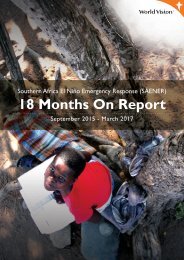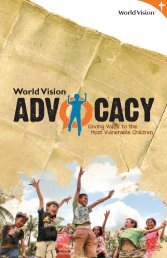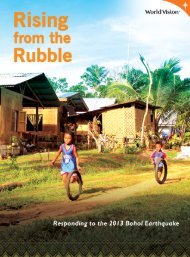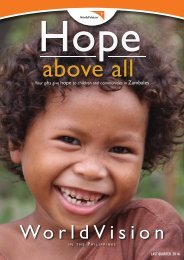INTER-AGENCY LIVELIHOOD ASSESSMENT - ARUA DISTRICT NORTHERN UGANDA GOAL
You also want an ePaper? Increase the reach of your titles
YUMPU automatically turns print PDFs into web optimized ePapers that Google loves.
In August 2015, a peace agreement was signed between the opposing parties under the auspices of<br />
regional and international communities and led to the formation of the Transitional Government Of<br />
National Unity (TGONU). Just as preparations were to implement the August 2015 peace agreement,<br />
a scuffle ensued in July 2016 pitting the presidential guards and the first vice president in Juba<br />
against each other. This dispute resulted in the Sudan People’s Liberation Army In Opposition (SPLA/<br />
IO) being pushed away from Juba. This conflict has now spread to densely populated and more remote<br />
regions of Equatorial region and brought mass displacement of people from the Equatorial region of<br />
South Sudan into neighbouring Uganda.<br />
Uganda, and in particular the West Nile region of Uganda, has a long history of hosting refugees<br />
from the neighbouring countries of Democratic Republic of Congo (DRC), Sudan and the present-day<br />
South Sudan. Since 2014, Uganda has seen a continuous influx of South Sudanese refugees fleeing<br />
from violence and destruction. As of June 2017, the United Nations High Commissioner for Refugees<br />
(UNHCR) had registered more than 950,000 South Sudanese refugees (mainly women and children)<br />
in Uganda who are resettled into the various settlements in the countryside of Uganda.<br />
This interagency needs assessment by World Vision Uganda (WVU), UNHCR and Caritas was<br />
conducted in two settlement areas of Rhino and Imvepi located in the West Nile Region of Uganda.<br />
The Imvepi settlement is the most recently opened area (February 2017) for resettlement and<br />
located about 72km east of the district town of Arua. This settlement is expected to resettle about<br />
100,000 South Sudanese refugees, the majority of them are remote peasant farmers fleeing from the<br />
conflict in the productive Equatorial region of South Sudan. This assessment will, therefore, propose<br />
immediate, medium and long-term strategies to address the livelihood needs of the refugee and host<br />
communities created by the changes in the environment and the pressure on the available resources<br />
to ensure smooth coexistence and sustainable utilization of resources.<br />
This study aims to:<br />
OBJECTIVES<br />
1. Assess the food security situation and coping mechanism of the refugees and their host<br />
communities<br />
2. Review livelihood activities, challenges faced and existing economic opportunities<br />
3. Identify the key driving factors to food insecurity and vulnerabilities for poorest households in<br />
targeted communities<br />
4. Identify appropriate short-term and long- term livelihood interventions for refugees and host<br />
community<br />
5. Provide recommendations on livelihood programming focus areas<br />
METHODOLOGY<br />
Stakeholder Consultations and Document Review<br />
In preparations for the assignment WVU, UNHCR and OPM engaged the Uganda government’s<br />
technical staff and peer organizations to discuss assessment details, encourage participation and pool<br />
of financial, logistical and human resources to support the study. The joint approach aimed to build a<br />
strong sense of ownership and up-take of the results of the study.<br />
8<br />
<strong>INTER</strong>-<strong>AGENCY</strong> <strong>LIVELIHOOD</strong> <strong>ASSESSMENT</strong> TARGETING REFUGEES AND<br />
HOST COMMUNITIES IN MVEPI AND RHINO CAMP SETTLEMNTS










